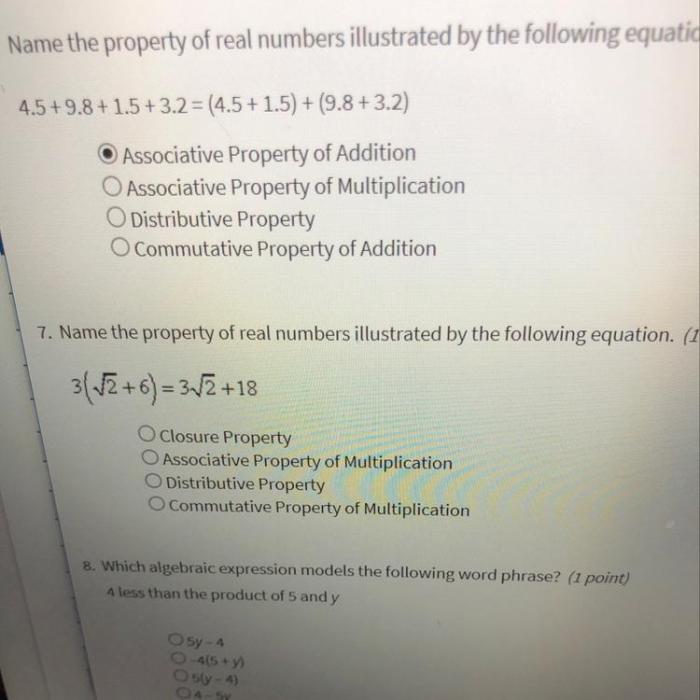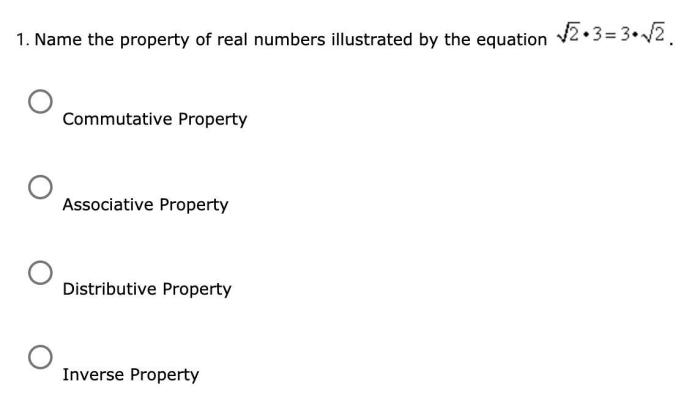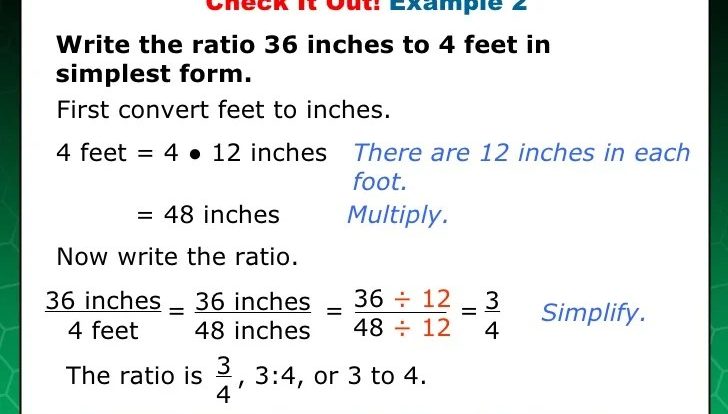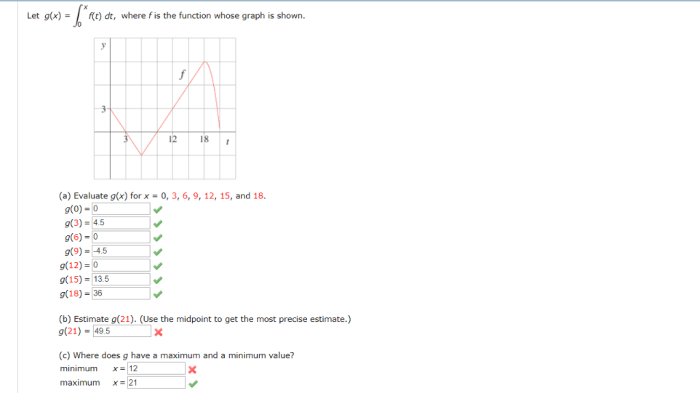Name the property of real numbers illustrated by the equation – The properties of real numbers are fundamental concepts that govern the behavior of numbers in mathematical operations. These properties, such as closure, commutativity, associativity, distributivity, identity, and inverse, play a crucial role in simplifying calculations, solving equations, and understanding the structure of the real number system.
In this exploration, we will delve into the fascinating world of real numbers, examining each property in detail through the lens of illustrative equations. By unraveling the intricacies of these properties, we gain a deeper appreciation for the elegance and power of mathematics.
Properties of Real Numbers

Real numbers possess several fundamental properties that govern their behavior in mathematical operations. These properties ensure the consistency and validity of mathematical equations and simplify complex calculations. This article explores the key properties of real numbers, illustrating each property with equations and providing examples of their applications in various scenarios.
Closure Property
The closure property states that the result of an operation between two real numbers is always a real number. For example, the sum of two real numbers is a real number, the product of two real numbers is a real number, and so on.
This property ensures that real numbers form a closed system under the operations of addition, subtraction, multiplication, and division (excluding division by zero).Examples of the closure property in action include:
- Adding 5 and 7 gives 12, which is a real number.
- Multiplying 3 by 4 gives 12, which is a real number.
- Subtracting 2 from 9 gives 7, which is a real number.
The closure property is crucial in mathematical operations, as it guarantees that the result of any valid operation will remain within the set of real numbers, maintaining the integrity and consistency of the number system.
Commutative Property
The commutative property states that the order of operands in an operation does not affect the result. For example, the sum of two real numbers is the same regardless of which number is added first, and the product of two real numbers is the same regardless of which number is multiplied first.Examples
of the commutative property in use include:
- 5 + 7 = 7 + 5, both of which equal 12.
- 3 × 4 = 4 × 3, both of which equal 12.
The commutative property simplifies mathematical calculations by allowing the rearrangement of operands without altering the outcome. This property is particularly useful in situations where the order of operands is not fixed or when calculations are performed mentally.
Associative Property
The associative property states that the grouping of operands in an operation does not affect the result. For example, the sum of three real numbers is the same regardless of how the numbers are grouped, and the product of three real numbers is the same regardless of how the numbers are grouped.Examples
of the associative property in practice include:
- (5 + 7) + 3 = 5 + (7 + 3), both of which equal 15.
- (3 × 4) × 5 = 3 × (4 × 5), both of which equal 60.
The associative property allows for the rearrangement of operands within an expression without changing its value, making complex calculations more manageable and efficient. This property is particularly useful in algebra, where expressions often involve multiple terms and groupings.
Distributive Property, Name the property of real numbers illustrated by the equation
The distributive property states that the multiplication of a number by the sum or difference of two other numbers is equal to the sum or difference of the products of the number by each of the other numbers.For example, 5 × (7 + 3) = (5 × 7) + (5 × 3)The distributive property is a fundamental property used in algebraic expressions and equations.
It allows for the simplification and expansion of complex expressions, making them easier to solve and manipulate.
Identity Property
The identity property states that the sum of any real number and zero is equal to the original number, and the product of any real number and one is equal to the original number.Examples of the identity property include:
- 5 + 0 = 5
- 3 × 1 = 3
The identity property serves as a neutral element in mathematical operations, ensuring that the value of a number remains unchanged when combined with its respective identity element (zero for addition and one for multiplication).
Inverse Property
The inverse property states that every real number has an additive inverse (a number that, when added to it, results in zero) and a multiplicative inverse (a number that, when multiplied by it, results in one).For example, the additive inverse of 5 is
5, and the multiplicative inverse of 3 is 1/3.
The inverse property is crucial in solving equations, as it allows for the isolation of variables and the determination of their values. It also forms the basis for concepts such as reciprocals and negative numbers.
Expert Answers: Name The Property Of Real Numbers Illustrated By The Equation
What is the closure property of real numbers?
The closure property states that when two real numbers are combined using a mathematical operation (addition, subtraction, multiplication, or division), the result is also a real number.
How is the commutative property used in daily life?
The commutative property is used whenever we rearrange the order of numbers in a calculation. For example, when adding two numbers, the sum remains the same regardless of the order in which they are added.
What are the practical applications of the associative property?
The associative property is used in computer science to optimize code efficiency and in physics to simplify complex calculations involving multiple forces.



